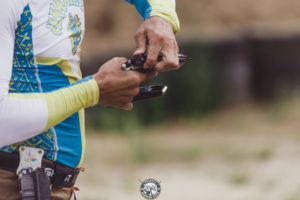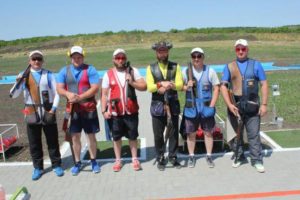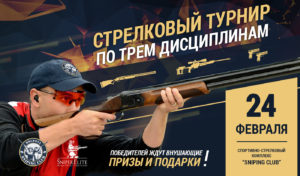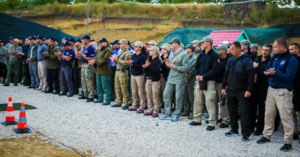
Articles
Firing history
History of development of clay shooting
History of origin, development and improvement of sports firing at the flying targets, i.e. that which call bench now is quite entertaining and is of interest for a wide range of hunters and fans of firing. In the standard opinion, sports firing since the beginning of the emergence was made on live pigeons, and artificial targets began to be used only over time. It and at the same time not absolutely so. artificial targets have been invented long ago, in the second half of the 19 century, i.e.at the time of rapid development of automotive firing at pigeons. It has occurred in the USA. Exactly their different types of clay shooting artificial targets have for the first time appeared. And first of all— “ladder”. The natives of Europe who have located on the modern United States have found the richest hunting grounds there. Occupations hunting and development of a fire arms promoted development of shooting skill.
In the USA the earliest competitions of shooters in the flying targets took place between professional duck’s hunters. The winner was defined simply: who will manage to get the greatest number of ducks for day of firing, that and the champion. As a matter of fact, it was the kind of sports firing at live birds, but in differed from the standard automotive firing, in particular, in the fact that occurred in the absence of the audience. And there were just not enough the last for the real competitions. To develop the skill, the American shooters practiced firing both at the rushes, and at swallows, and even on bats. But gradually pigeons became the main target for competitions: them was enough and they were easy to be contained.
The first record about such competitions held by sports club of the city of Cincinnati (the State of Ohio, English Cincinnati, Ohio), is dated 1831. Practically without special changes automotive firing was conducted to the middle of the 1860th years. Then time of the artificial flying targets has come. And the reasons for this purpose was at least two. First, sports firing at live birds was perceived by different people, and even hunters, ambiguously. But there was also one more absolutely other reason. Firing at live birds owing to a certain limitation of their quantity did not give the chance to be shot and train much. Why— it is clear also without special explanations. Besides, the 1860th years are time when central battle rifle have begun to succeed slowly loaded ramrod weapon. Both whatever imperfect and weak they still were, rate of fire, i.e. readiness for firing, has sharply increased that has given the chance to reduce time for preparation fora shot. There was a need for as to giving of targets to the shooter. So— inartificial targets.
Glass spheres became such targets. Assume that for the first time they have appeared in England about 1850. However, their broad production and use as targets for firing has received popularity in the USA. Historians of weapon unanimously tell the name of Charles Portlok from Boston, the one who has entered it into practice and has organized the first competitions in1867. However, ten more years were required to improve this type of firing. The first spheres rushed hands. Their flight was slow and predictable and they flew away nearby. Therefore, firing at them has not attracted long interest.
Situation has radically changed in1877when the famous American shooter of that time Adam Bogardus has invented “machine” for a pelting of such glass spheres. The machine, or “ladder” (English trap), throwing spheres at least on 50meters, has made firing more interesting and, the main thing, spectacular. Spheres have also been “improved”, and Bogardus in the same1877 has patented several their models. If the surface of the first spheres was smooth, then at the second generation it became corrugated. It became with the purpose to avoid sliding of fraction at hit in a sphere and by that to reduce blow force.
Popularity of firing at spheres has demanded creation of certain rules. The shooter became in18yards (16,4meters) from the machine which threw out a sphere. At competitions three machines were used. Left threw a sphere to the left, right— to the right, and central threw a sphere so that it was hijacked. The waiter, he, as a rule, and the judge, started the machine at discretion so the shooter practically did not know where the sphere will depart. Diameter of a sphere made about 3inches (7-9 cm). All this gave to firing sports character and did it rather interesting.
Demand gives rise to the offer therefore in a number of states of the USA glass works began to release such spheres targets. Their color varied from light yellow to almost black. On many spheres there were texts with the indication of the plants making them. It is interesting that the glass works which more than hundred years ago was letting out them in the State of New Jersey has still remained. Each plant did a corrugated or rough surface of a sphere at discretion. Announcements in the American newspapers of that time say that spheres with a corrugated surface cost one dollar thirty-five cents for hundred pieces, then so with a smooth surface— only one dollar for one hundred. For bigger staginess when firing spheres were sometimes filled with bird’s feathers or any powder, and even just sand. The last way, besides, made heavier a sphere, promoting its more distant pelting. In the USA where with great interest treat a collecting of the objects connected with weapon and hunting there are fans collecting such glass spheres. A time they are found in sand in those places where once sports clubs have been located. Sometimes spheres used as jewelry for Christmas trees, and thus they have remained.
History has informed of several names which have become well-known thanks to shooting results our time. One of them— A.Bogardus who is already mentioned above. Another— Dr. V. Carver who has got a nickname “Dock” in the childhood for the addiction to treat all animals and birds who have got into trouble. They were irreconcilable rivals at shooting competitions. In1877 and1898 A.Bogardus has written and has published two books devoted to shooting sport of that time. The important place in them is given to its own victories. Carver has also written the book in which has expressed itself more modestly and which name can be translated approximately so: “Spirit of weapon of the Wild West”. Many years he was engaged in industrial hunting for bison’s and as historian’s write, has achieved success in this case.
Duels between Bogardus and Carver brought a victory to one, another. It is interesting that conditions in competitions were very different in those days: not only to break as much as possible targets from100. For example, agreed that the one who will break 100 spheres for smaller time, or the one who will break spheres from a rifle more, or in general the one who will break spheres more in a day will be a winner, etc. Bogardus belongs such record known in the West — 4844 spheres from5000 in500minutes! In1879 it has broken the 5500th glass a sphere in440 minutes and has missed only 356spheres. Having trained in firing at artificial targets, both shooters showed good results and in automotive firing at pigeons both in the USA, and in Europe on which they made a tour from time to time. In1883 at competitions on cages both shot in the city of Louisville (State of Kentucky) at live pigeons and the victory with overweight in only one bird was pulled out by Carver.
Now, continuing a conversation on origin and development of clay shooting, we will mention and the third names American Ligovski. It has become history of this sport the fact that has offered as a target the clay plateau which has received in the West the name Clay Pigeon — “a clay pigeon”. To year Ligovski has patented B1880 not only the flying target, but also the machine for its throwing. The inventor gave the following advantages of “a clay pigeon”: first, it is nota live target, and secondly, does not leave “in the battlefield “a pile of the broken glass.
Ligovski for the purpose of promoting of the invention has invited to participate in demonstration competitions of friends rivals— Bogardus and the Carver. Have agreed to play a series of matches in a number of the cities, shooting on100 targets in everyone. For increase in interest everyone broken82 (and more) targets from100 received 100dollars, and the winner of 300 more dollars— the sums for those times very impressive. Bogardus has broken 2103 targets from2500, but has been won by Carver who has struck 2227 “clay pigeons”.
It would seem, it was possible to assume that introduction to practice of “clay pigeons” will put an end to firing at glass spheres. It has in practice turned out not so. Clay was not the most successful material for production of plateaus, even while added impurity for fragility to it. Production of glass spheres has continued up to1920-hgod. They were done in the USA, Canada and England, but it is possible, and somewhere else. In Russia, shooting was practiced at booths on firewood – balls and plates – but there seems to be no information on the production of glass balls for shooting in Russian hunting literature. Real plates began to be used as targets after a new material was found for their production – coal tar pitch (with the addition of 40 other components, such as chalk, cement and even sawdust). This made the plates strong when thrown by the throwing machine and at the same time fragile when the shot comes into contact.
So, having arisen on the American continent, firing on a ladder has quickly won admirers at first in Europe, and then and around the world. But fundamental differences between rules of firing in America and in Europe remained up to now. In America on a plateau on a ladder it is fired by one shot. In Europe and in our country— by international rules, i.e. the first are allowed to shoot two shots in case of a miss. Firing in the World Cups, the Olympic Games and other large international competitions is also conducted by international rules. It is clear, that shoot from double-barreled guns. And here on the American continent— from single-barreled.
During the development sports and hunting firing has gained a considerable variety. But by the most popular and, it is possible to claim safely that also the sporting became the most interesting form of firing at plateaus. This sport which has gained today recognition around the world is continuation of that firing which since the end of the 1880th years was offered at the known European and American shooting schools for improvement in hunting firing. At first such firing was considered only as a way of a training, but it became an independent type of shooting sport soon. By the end of the 19th century most the known firm’s arms manufacturers had own shooting schools or shooting ranges. Attribute to Charles Lancaster creation of the first modern school. Nevertheless, Joseph Lang had a shooting gallery for trainings and adjustment of ammunition in1827. Kogsvell and Harrison also became known thanks to the to “The shooting park” in Kolnbruk, the suburb of London. In1888what we would call a sporting today was offered to visitors there. Serious competitions in a sporting were not held before the end of World War I.
The first in England “The sports firing championship among nonprofessionals” has been held in1925. Nowadays main competition in a sporting in the United Kingdom is the British Open championship which site of negotiations changes, but earlier it was for many years carried out on a shooting range to Perivale (the Western London). Ina sporting of arrows should strike the most different targets. The main idea consists that targets should imitate the movements of a live game, and is always observed. Therefore, on a shooting site to you such targets as “the flying pigeon”, “teal”, “the flying-away partridge”, “pheasant “or “the running rabbit” can meet.
Other articles







